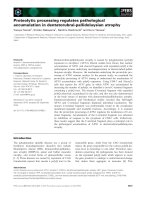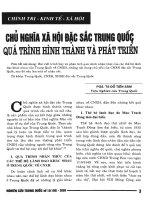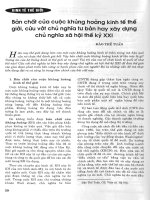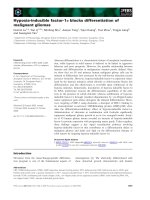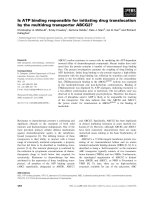Tài liệu Báo cáo khoa học: "Sentiment Vector Space Model for Lyric-based Song Sentiment Classification" pdf
Bạn đang xem bản rút gọn của tài liệu. Xem và tải ngay bản đầy đủ của tài liệu tại đây (95.11 KB, 4 trang )
Proceedings of ACL-08: HLT, Short Papers (Companion Volume), pages 133–136,
Columbus, Ohio, USA, June 2008.
c
2008 Association for Computational Linguistics
Sentiment Vector Space Model for
Lyric-based Song Sentiment Classification
Yunqing Xia Linlin Wang
Center for Speech and language Tech. State Key Lab of Intelligent Tech. and Sys.
RIIT, Tsinghua University Dept. of CST, Tsinghua University
Beijing 100084, China Beijing 100084, China
Kam-Fai Wong Mingxing Xu
Dept. of SE&EM Dept. of CST
The Chinese University of Hong Kong Tsinghua University
Shatin, Hong Kong Beijing 100084, China
Abstract
Lyric-based song sentiment classification
seeks to assign songs appropriate sentiment
labels such as light-hearted and heavy-hearted.
Four problems render vector space model
(VSM)-based text classification approach in-
effective: 1) Many words within song lyrics
actually contribute little to sentiment; 2)
Nouns and verbs used to express sentiment are
ambiguous; 3) Negations and modifiers
around the sentiment keywords make particu-
lar contributions to sentiment; 4) Song lyric is
usually very short. To address these problems,
the sentiment vector space model (s-VSM) is
proposed to represent song lyric document.
The preliminary experiments prove that the s-
VSM model outperforms the VSM model in
the lyric-based song sentiment classification
task.
1 Introduction
Song sentiment classification nowadays becomes a
hot research topic due largely to the increasing
demand of ubiquitous song access, especially via
mobile phone. In their music phone W910i, Sony
and Ericsson provide Sense Me component to catch
owner’s mood and play songs accordingly. Song
sentiment classification is the key technology for
song recommendation. Many research works have
been reported to achieve this goal using audio sig-
nal (Knees et al., 2007). But research efforts on
lyric-based song classification are very few.
Preliminary experiments show that VSM-based
text classification method (Joachims, 2002) is inef-
fective in song sentiment classification (see Sec-
tion 5) due to the following four reasons. Firstly,
the VSM model considers all content words within
song lyric as features in text classification. But in
fact many words in song lyric actually make little
contribution to sentiment expressing. Using all
content words as features, the VSM-based classifi-
cation methods perform poorly in song sentiment
classification. Secondly, observation on lyrics of
thousands of Chinese pop songs reveals that senti-
ment-related nouns and verbs usually carry multi-
ple senses. Unfortunately, the ambiguity is not
appropriately handled in the VSM model. Thirdly,
negations and modifiers are constantly found
around the sentiment words in song lyric to inverse,
to strengthen or to weaken the sentiments that the
sentences carry. But the VSM model is not capable
of reflecting these functions. Lastly, song lyric is
usually very short, namely 50 words on average in
length, rendering serious sparse data problem in
VSM-based classification.
To address the aforementioned problems of the
VSM model, the sentiment vector space model (s-
VSM) is proposed in this work. We adopt the s-
VSM model to extract sentiment features from
song lyrics and implement the SVM-light
(Joachims, 2002) classification algorithm to assign
sentiment labels to given songs.
133
2 Related Works
Song sentiment classification has been investigated
since 1990s in audio signal processing community
and research works are mostly found relying on
audio signal to make a decision using machine
learning algorithms (Li and Ogihara, 2006; Lu et
al., 2006). Typically, the sentiment classes are de-
fined based on the Thayer’s arousal-valence emo-
tion plane (Thayer, 1989). Instead of assigning
songs one of the four typical sentiment labels, Lu
et al. (2006) propose the hierarchical framework to
perform song sentiment classification with two
steps. In the first step the energy level is detected
with intensity features and the stress level is de-
termined in the second step with timbre and
rhythm features. It is proved difficult to detect
stress level using audio as classification proof.
Song sentiment classification using lyric as
proof is recently investigated by Chen et al. (2006).
They adopt the hierarchical framework and make
use of song lyric to detect stress level in the second
step. In fact, many literatures have been produced
to address the sentiment analysis problem in natu-
ral language processing research. Three approaches
are dominating, i.e. knowledge-based approach
(Kim and Hovy, 2004), information retrieval-based
approach (Turney and Littman, 2003) and machine
learning approach (Pang et al., 2002), in which the
last approach is found very popular. Pang et al.
(2002) adopt the VSM model to represent product
reviews and apply text classification algorithms
such as Naïve Bayes, maximum entropy and sup-
port vector machines to predict sentiment polarity
of given product review.
Chen et al. (2006) also apply the VSM model in
lyric-based song sentiment classification. However,
our experiments show that song sentiment classifi-
cation with the VSM model delivers disappointing
quality (see Section 5). Error analysis reveals that
the VSM model is problematic in representing
song lyric. It is necessary to design a new lyric rep-
resentation model for song sentiment classification.
3 Sentiment Vector Space Model
We propose the sentiment vector space model (s-
VSM) for song sentiment classification. Principles
of the s-VSM model are listed as follows.
(1) Only sentiment-related words are used to pro-
duce sentiment features for the s-VSM model.
(2) The sentiment words are appropriately disam-
biguated with the neighboring negations and
modifiers.
(3) Negations and modifiers are included in the s-
VSM model to reflect the functions of invers-
ing, strengthening and weakening.
Sentiment unit is found the appropriate element
complying with the above principles.
To be general, we first present the notation for
sentiment lexicon as follows.
, ,1},{
, ,1},{
, ,1},{ };,,{
LlmM
JjnN
IicCMNCL
l
j
i
==
==
=
=
=
in which L represents sentiment lexicon, C senti-
ment word set, N negation set and M modifier set.
These words can be automatically extracted from a
semantic dictionary and each sentiment word is
assigned a sentiment label, namely light-hearted or
heavy-hearted according to its lexical definition.
Given a piece of song lyric, denoted as follows,
HhwW
h
, ,1},{ =
=
in which W denotes a set of words that appear in
the song lyric, the semantic lexicon is in turn used
to locate sentiment units denoted as follows.
MWmNWnCWc
mncuU
vlvjvi
vlvjviv
∩∈∩∈∩∈
=
=
,,,
,,,
; ;,
},,{}{
Note that sentiment units are unambiguous sen-
timent expressions, each of which contains one
sentiment word and possibly one modifier and one
negation. Negations and modifiers are helpful to
determine the unique meaning of the sentiment
words within certain context window, e.g. 3 pre-
ceding words and 3 succeeding words in our case.
Then, the s-VSM model is presented as follows.
))(), ,(),((
21
UfUfUfV
TS
=
.
in which V
S
represents the sentiment vector for the
given song lyric and f
i
(U) sentiment features which
are usually certain statistics on sentiment units that
appear in lyric.
We classify the sentiment units according to oc-
currence of sentiment words, negations and modi-
fiers. If the sentiment word is mandatory for any
sentiment unit, eight kinds of sentiment units are
obtained. Let f
PSW
denote count of positive senti-
134
ment words (PSW), f
NSW
count of negative senti-
ment words (NSW), f
NEG
count of negations (NEG)
and f
MOD
count of modifiers (MOD). Eight senti-
ment features are defined in Table 1.
f
i
Number of sentiment units satisfying …
f
1
f
PSW
>0, f
NSW
=f
NEG
=f
MOD
=0
f
2
f
PSW
=0, f
NSW
>0, f
NEG
= f
MOD
=0
f
3
f
PSW
>0, f
NSW
=0, f
NEG
>0, f
MOD
=0
f
4
f
PSW
=0, f
NSW
>0, f
NEG
>0, f
MOD
=0
f
5
f
PSW
>0, f
NSW
=0, f
NEG
=0, f
MOD
>0
f
6
f
PSW
=0, f
NSW
>0, f
NEG
=0, f
MOD
>0
f
7
f
PSW
>0, f
NSW
=0, f
NEG
>0, f
MOD
>0
f
8
f
PSW
=0, f
NSW
>0, f
NEG
>0, f
MOD
>0
Table 1. Definition of sentiment features. Note that
one sentiment unit contains only one sentiment
word. Thus it is not possible that f
PSW
and f
NSW
are
both bigger than zero.
Obviously, sparse data problem can be well ad-
dressed using statistics on sentiment units rather
than on individual words or sentiment units.
4 Lyric-based Song Sentiment Classifica-
tion
Song sentiment classification based on lyric can be
viewed as a text classification task thus can be
handled by some standard classification algorithms.
In this work, the SVM-light algorithm is imple-
mented to accomplish this task due to its excel-
lence in text classification.
Note that song sentiment classification differs
from the traditional text classification in feature
extraction. In our case, sentiment units are first
detected and the sentiment features are then gener-
ated based on sentiment units. As the sentiment
units carry unambiguous sentiments, it is deemed
that the s-VSM is model is promising to carry out
the song sentiment classification task effectively.
5 Evaluation
To evaluate the s-VSM model, a song corpus, i.e.
5SONGS, is created manually. It covers 2,653 Chi-
nese pop songs, in which 1,632 are assigned label
of light-hearted (positive class) and 1,021 assigned
heavy-hearted (negative class). We randomly se-
lect 2,001 songs (around 75%) for training and the
rest for testing. We adopt the standard evaluation
criteria in text classification, namely precision (p),
recall (r), f-1 measure (f) and accuracy (a) (Yang
and Liu, 1999).
In our experiments, three approaches are imple-
mented in song sentiment classification, i.e. audio-
based (AB) approach, knowledge-based (KB) ap-
proach and machine learning (ML) approach, in
which the latter two approaches are also referred to
as text-based (TB) approach. The intentions are 1)
to compare AB approach against the two TB ap-
proaches, 2) to compare the ML approach against
the KB approach, and 3) to compare the VSM-
based ML approach against the s-VSM-based one.
Audio-based (AB) Approach
We extract 10 timbre features and 2 rhythm fea-
tures (Lu et al., 2006) from audio data of each song.
Thus each song is represented by a 12-dimension
vector. We run SVM-light algorithm to learn on the
training samples and classify test ones.
Knowledge-based (KB) Approach
We make use of HowNet (Dong and dong,
2006), to detect sentiment words, to recognize the
neighboring negations and modifiers, and finally to
locate sentiment units within song lyric. Sentiment
(SM) of the sentiment unit (SU) is determined con-
sidering sentiment words (SW), negation (NEG)
and modifiers (MOD) using the following rule.
(1) SM(SU) = label
(SW);
(2) SM(SU) = - SM(SU) iff SU contains NEG;
(3) SM(SU) = degree(MOD)*SM(SU) iff SU
contains MOD.
In the above rule, label(x) is the function to read
sentiment label(∈{1, -1}) of given word in the
sentiment lexicon and degree(x) to read its modifi-
cation degree(∈{1/2, 2}). As the sentiment labels
are integer numbers, the following formula is
adopted to obtain label of the given song lyric.
⎟
⎠
⎞
⎜
⎝
⎛
=
∑
i
i
SUSMsignlabel )(
Machine Learning (ML) Approach
The ML approach adopts text classification al-
gorithms to predict sentiment label of given song
lyric. The SVM-light algorithm is implemented
based on VSM model and s-VSM model, respec-
tively. For the VSM model, we apply (CHI) algo-
rithm (Yang and Pedersen, 1997) to select effective
sentiment word features. For the s-VSM model, we
adopt HowNet as the sentiment lexicon to create
sentiment vectors.
Experimental results are presented Table 2.
135
p R f-1 a
Audio-based 0.504 0.701 0.586 0.504
Knowledge-based 0.726 0.584 0.647 0.714
VSM-based 0.587
1.000
0.740 0.587
s-VSM-based
0.783
0.750
0.766 0.732
Table 2. Experimental results
Table 2 shows that the text-based methods out-
perform the audio-based method. This justifies our
claim that lyric is better than audio in song senti-
ment detection. The second observation is that ma-
chine learning approach outperforms the
knowledge-based approach. The third observation
is that s-VSM-based method outperforms VSM-
based method on f-1 score. Besides, we surpris-
ingly find that VSM-based method assigns all test
samples light-hearted label thus recall reaches
100%. This makes results of VSM-based method
unreliable. We look into the model file created by
the SVM-light algorithm and find that 1,868 of
2,001 VSM training vectors are selected as support
vectors while 1,222 s-VSM support vectors are
selected. This indicates that the VSM model indeed
suffers the problems mentioned in Section 1 in
lyric-based song sentiment classification. As a
comparison, the s-VSM model produces more dis-
criminative support vectors for the SVM classifier
thus yields reliable predictions.
6 Conclusions and Future Works
The s-VSM model is presented in this paper as a
document representation model to address the
problems encountered in song sentiment classifica-
tion. This model considers sentiment units in fea-
ture definition and produces more discriminative
support vectors for song sentiment classification.
Some conclusions can be drawn from the prelimi-
nary experiments on song sentiment classification.
Firstly, text-based methods are more effective than
the audio-based method. Secondly, the machine
learning approach outperforms the knowledge-
based approach. Thirdly, s-VSM model is more
reliable and more accurate than the VSM model.
We are thus encouraged to carry out more research
to further refine the s-VSM model in sentiment
classification. In the future, we will incorporate
some linguistic rules to improve performance of
sentiment unit detection. Meanwhile, sentiment
features in the s-VSM model are currently equally
weighted. We will adopt some estimation tech-
niques to assess their contributions for the s-VSM
model. Finally, we will also explore how the s-
VSM model improves quality of polarity classifi-
cation in opinion mining.
Acknowledgement
Research work in this paper is partially supported
by NSFC (No. 60703051) and Tsinghua University
under the Basic Research Foundation (No.
JC2007049).
References
R.H. Chen, Z.L. Xu, Z.X. Zhang and F.Z. Luo. Content
Based Music Emotion Analysis and Recognition.
Proc. of 2006 International Workshop on Computer
Music and Audio Technology, pp.68-75. 2006.
Z. Dong and Q. Dong. HowNet and the Computation of
Meaning. World Scientific Publishing. 2006.
T. Joachims. Learning to Classify Text Using Support
Vector Machines, Methods, Theory, and Algorithms.
Kluwer (2002).
S M. Kim and E. Hovy. Determining the Sentiment of
Opinions. Proc. COLING’04, pp. 1367-1373. 2004.
P. Knees, T. Pohle, M. Schedl and G. Widmer. A Music
Search Engine Built upon Audio-based and Web-
based Similarity Measures. Proc. of SIGIR'07, pp.47-
454. 2007
T. Li and M. Ogihara. Content-based music similarity
search and emotion detection. Proc. IEEE Int. Conf.
Acoustic, Speech, and Signal Processing, pp. 17–21.
2006.
L. Lu, D. Liu and H. Zhang. Automatic mood detection
and tracking of music audio signals. IEEE Transac-
tions on Audio, Speech & Language Processing
14(1): 5-18 (2006).
B. Pang, L. Lee and S. Vaithyanathan. Thumbs up? Sen-
timent Classification using Machine Learning Tech-
niques. Proc. of EMNLP-02, pp.79-86. 2002.
R. E. Thayer, The Biopsychology of Mood and Arousal,
New York, Oxford University Press. 1989.
P. D. Turney and M. L. Littman. Measuring praise and
criticism: Inference of semantic orientation from as-
sociation. ACM Trans. on Information Systems,
21(4):315–346. 2003.
Y. Yang and X. Liu. A Re-Examination of Text Catego-
rization Methods. Proc. of SIGIR’99, pp. 42-49. 1999.
Y. Yang and J. O. Pedersen. A comparative study on
feature selection in text categorization. Proc.
ICML’97, pp.412-420. 1997.
136

